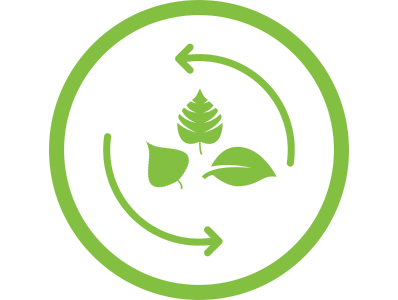The second week of Circular Economy Month focuses on the environmental benefits of the circular economy. Learn about how circularity can tackle climate change and what you can do to reduce your environmental impact.
The circular economy can improve the value of natural resources, reduce carbon emissions, and eliminate waste. It benefits the environment–and by extension, humans and biodiversity–in several ways:

Tackling Climate Change
To achieve Canada’s climate targets, we must think beyond conventional solutions and embrace innovative approaches. Embodied carbon, the emissions associated with the products we make and use daily, account for a staggering 45% of our carbon emission targets. Circular economies tackle embodied carbon by promoting production and consumption practices that do more with less.

Cleaner Water and Water Conservation
Clean water is critical for the health of all living systems and it’s threatened by contamination from harmful plastics and overuse. Canadians throw away 3 million tonnes of plastic waste every year. Only 9% is recycled while the rest ends up in landfills, waste-to-energy facilities, or the environment. By keeping plastics in a closed loop and out of the environment, a circular economy can reduce the amount of plastic waste and microplastics in our waterways, improving water quality for all. Further, when circular systems keep natural resources in use, we significantly reduce the amount of water required to make products.

Increased Resource Recovery
By keeping products in use and out of the landfill, we reduce the extraction of new resources from the earth and generate more demand for keeping that material in use for as long as possible. For example, recycling electronics provides a local source for rare earth metals (which are required to make new devices), thereby reducing the need for harmful mining practices. By generating demand for recycled paper goods, we reduce our impact on forests – which provide an ecosystem service by reducing carbon dioxide and producing the oxygen we breathe.

Expand the Definition of Wealth
By giving ecosystems time to heal and diversify, we are improving the available natural capital. Natural capital (put in economic terms) is all the goods and services that nature provides us. Over half of the world’s wealth ($44 trillion in GDP) depends at least moderately, if not highly, on natural capital. By taking natural capital and ecosystem services into account in economic and financial models, decision makers can make better-informed choices.

Increased Biodiversity
Biodiversity brings many benefits, including improved food security, water, air, and the health of all living beings. It generally makes us more resilient, helping organisms adapt to changes in the environment. However, land and aquatic species populations are declining. Overuse of Earth’s resources contributes over 90% of this biodiversity loss. The circular economy reduces the demand for new resources, thereby preserving and regenerating natural habitats and biodiversity, as well as capturing and storing carbon.

Less Waste
Extending the life cycle of products and materials for as long as possible reduces the amount of waste sent to landfill and polluting our environment. Learn all about the benefits of specific types of waste reduction in a circular economy in Week Three of Circular Economy Month: Waste Reduction Week in Canada!
Facts and Stats
- Plastic pollution has been discovered in groundwater, oceans, rivers, lakes, and even drinking water around the globe.
- By transitioning to a Circular Economy for plastics, Canadians can prevent 1.8 megatonnes of carbon dioxide equivalents from entering the atmosphere every year
- It takes 2,700 liters of fresh water to grow the amount of cotton needed to make just one cotton t-shirt.
- The populations of vertebrate species has declined by approximately 68% since 1970 – with freshwater species being hit the hardest.
